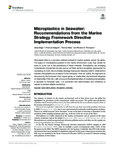Microplastics in Seawater: Recommendations from the Marine Strategy Framework Directive Implementation Process
| dc.contributor.author | Gago, J | |
| dc.contributor.author | Galgani, F | |
| dc.contributor.author | Maes, T | |
| dc.contributor.author | Thompson, Richard | |
| dc.date.accessioned | 2017-08-11T09:04:57Z | |
| dc.date.available | 2017-08-11T09:04:57Z | |
| dc.date.issued | 2016-11-08 | |
| dc.identifier.issn | 2296-7745 | |
| dc.identifier.issn | 2296-7745 | |
| dc.identifier.other | ARTN 219 | |
| dc.identifier.uri | http://hdl.handle.net/10026.1/9759 | |
| dc.description.abstract |
Microplastic litter is a pervasive pollutant present in marine systems across the globe. The legacy of microplastics pollution in the marine environment today may remain for years to come due to the persistence of these materials. Microplastics are emerging contaminants of potential concern and as yet there are few recognized approaches for monitoring. In 2008, the EU Marine Strategy Framework Directive (MSFD, 2008/56/EC) included microplastics as an aspect to be measured. Here we outline the approach as discussed by the European Union expert group on marine litter, the technical Subgroup on Marine litter (TSG-ML), with a focus on the implementation of monitoring microplastics in seawater in European seas. It is concluded that harmonization and coherence is needed to achieve reliable monitoring. | |
| dc.format.extent | 219- | |
| dc.language.iso | en | |
| dc.publisher | Frontiers Media SA | |
| dc.subject | marine debris | |
| dc.subject | plastics | |
| dc.subject | microplastics | |
| dc.subject | monitoring | |
| dc.title | Microplastics in Seawater: Recommendations from the Marine Strategy Framework Directive Implementation Process | |
| dc.type | journal-article | |
| dc.type | Journal Article | |
| plymouth.author-url | https://www.webofscience.com/api/gateway?GWVersion=2&SrcApp=PARTNER_APP&SrcAuth=LinksAMR&KeyUT=WOS:000457358000215&DestLinkType=FullRecord&DestApp=ALL_WOS&UsrCustomerID=11bb513d99f797142bcfeffcc58ea008 | |
| plymouth.issue | NOV | |
| plymouth.volume | 3 | |
| plymouth.publication-status | Published | |
| plymouth.journal | Frontiers in Marine Science | |
| dc.identifier.doi | 10.3389/fmars.2016.00219 | |
| plymouth.organisational-group | /Plymouth | |
| plymouth.organisational-group | /Plymouth/Faculty of Science and Engineering | |
| plymouth.organisational-group | /Plymouth/Faculty of Science and Engineering/School of Biological and Marine Sciences | |
| plymouth.organisational-group | /Plymouth/REF 2021 Researchers by UoA | |
| plymouth.organisational-group | /Plymouth/REF 2021 Researchers by UoA/UoA07 Earth Systems and Environmental Sciences | |
| plymouth.organisational-group | /Plymouth/Research Groups | |
| plymouth.organisational-group | /Plymouth/Research Groups/Marine Institute | |
| plymouth.organisational-group | /Plymouth/Users by role | |
| plymouth.organisational-group | /Plymouth/Users by role/Academics | |
| plymouth.organisational-group | /Plymouth/Users by role/Researchers in ResearchFish submission | |
| dcterms.dateAccepted | 2016-10-24 | |
| dc.identifier.eissn | 2296-7745 | |
| dc.rights.embargoperiod | No embargo | |
| rioxxterms.versionofrecord | 10.3389/fmars.2016.00219 | |
| rioxxterms.licenseref.uri | http://www.rioxx.net/licenses/all-rights-reserved | |
| rioxxterms.licenseref.startdate | 2016-11-08 | |
| rioxxterms.type | Journal Article/Review | |
| plymouth.oa-location | https://doi.org/10.3389/fmars.2016.00219 |


